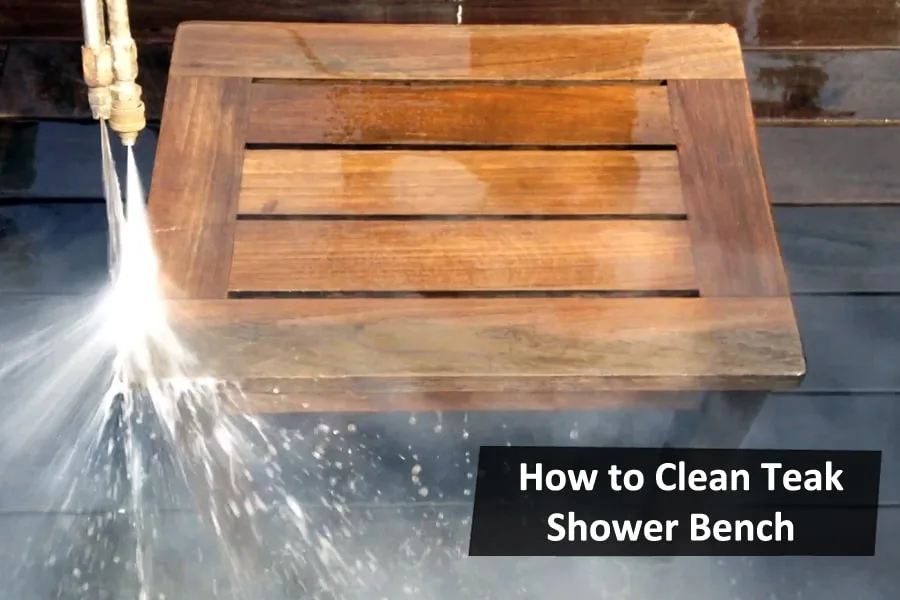Teak shower benches are excellent additions to any bathroom, combining both utility and style. To ensure their longevity, regular cleaning is crucial, with a recommended schedule of every two months or more frequently, depending on usage.
Despite concerns about maintenance, teak furniture is generally low-maintenance, requiring periodic cleaning and oiling to preserve its color and shine.
These simple steps, carried out quarterly or semi-annually, will maintain the benches in a fresh and youthful condition, ensuring they adorn your bathroom for years to come.
Follow this step-by-step guide to proper teak furniture care and enjoy the benefits of this elegant and durable addition.

How to Clean Teak Shower Bench?
Teak is naturally resistant to mildew and bacteria, but it can accumulate dirt from minerals and soap residue in water. To maintain a clean teak shower bench, establish a routine cleaning plan.
The following methods and steps provide an effective guide for teak bench care.
Method 1: Vinegar & Dish Soap Cleaning Solution
Cleaning your shower bench with a homemade solution is the most convenient and efficient approach.
Step 1: Prepare the Homemade Cleaner Solution
Take half a cup of vinegar and place it in a bowl. Add half a cup of warm water to the vinegar.
Incorporate two tablespoons of dish soap into the solution. Thoroughly mix the ingredients to create the cleaning solution.
Your cleaning solution is now ready. However, if you prefer a ready-made option, various branded teak cleaners are available both online and offline.
Step 2: Apply the Solution to the Teak Shower Bench
Apply the homemade cleaning solution to the teak shower bench. Use a brush to evenly distribute the solution across all surfaces.
Allow the solution to sit for a few minutes. Employ a soft-bristle scrubber to gently brush the solution over the bench, ensuring thorough coverage. Pay attention to the corners and gaps during this process.
Step 3: Rinsing the Solution off Teak Shower Bench
Rinse the bench with clean water. Use the scrubber to remove any residual solution.
Repeat the rinsing process several times until the cleaning solution is completely washed away.
Step 4: Dry & Apply Teak Oil
Allow the teak shower bench to dry completely (which may take a few hours). Once dry, apply teak oil for nourishment and protection.
Method 2: Cleaning a Teak Shower Bench with Bleach
While vinegar is suitable for light teak bench cleaning, stubborn mold growth may require bleach for a more effective solution. Follow these steps to clean your teak shower bench using bleach:
Step 1: Prepare the Bleach Solution
Obtain the desired quantity of bleach solution. Mix it with water at a 1:4 ratio (e.g., add 1 liter of bleach to 4 liters of water). Thoroughly blend the solution using an appropriate mixing tool.
Step 2: Apply the Solution to the Teak Shower Bench
Generously apply the bleach mixture to the teak shower bench. Use a paintbrush to ensure even coverage on visible surfaces.
Employ a toothbrush to access corners and gaps. Allow the solution to settle for a few minutes.
Step 3: Scrub and Rinse
Use a soft scrubber for this step. Scrub the solution onto the bench, targeting tough stains and build-up.
Rinse the teak shower bench with clean water, thoroughly removing the solution from the surface. Pay special attention to cleaning solution remnants in corners and gaps.
Step 4: Let It Dry and Apply Teak Oil
Allow the teak shower bench to air dry. Apply teak oil for additional protection once the bench is dry. Let the oil settle before using the bench again.
How to Remove Soap Scum from Teak Shower Bench
Step 01: Gather the Necessary Materials
Begin by assembling the essential materials for the soap scum removal process. Proper selection is crucial to prevent damage to the teak wood.
A safe and effective option is vinegar, a natural cleaner. Mix equal parts of vinegar and water and transfer the solution into a spray bottle.
You’ll also need a scrub brush or sponge for applying the cleaning solution to the shower bench. With these materials, you can efficiently and safely remove soap scum without harming the wood.
Step 02: Clean the Teak Shower Bench
To preserve the pristine appearance of your wooden shower seat, regular cleaning and sanitizing are essential. Proper teak maintenance ensures the longevity of your shower bench.
Before using any cleaning solution, wipe the surface clean with a dry cloth. Avoid harsh chemicals and abrasive materials, as they can damage the wood.
Instead, opt for natural cleaning solutions like vinegar, lemon juice, or a mixture of baking soda and water. Apply the chosen solution to the surface and gently scrub with a soft-bristled brush.
Thoroughly rinse the bench with water and dry it with a clean cloth. Regular cleaning will maintain the teak’s natural beauty, keeping it looking new for years.
Preventing Soap Scum Buildup on Teak Shower Bench
To prevent the unsightly accumulation of soap scum on your wooden shower seat, consistent maintenance is crucial.
After each use, wipe the bench down with a dry towel to remove excess water, which can lead to soap scum buildup.
Consider using a squeegee after each shower to remove lingering water, effectively preventing soap scum from forming.
Another preventative measure is to use a mixture of equal parts water and vinegar to wipe down the bench, which helps break down existing soap scum and deters future buildup.
Regular maintenance not only prevents soap scum but also extends the lifespan of your teak shower bench, preserving its natural elegance.
How to Clean Mold off Teak SHower Bench
Mold on teak shower benches can be a troublesome issue, but with the right supplies and methods, it can be easily managed with minimal time and effort.
Method 1: Using Vinegar & Dish Wash Soap
Materials Needed
- Water
- Soft-bristle brush
- Dish soap or Detergent
- Vinegar
- Bucket or Bowl
- Spray bottle
- Cleaning sponge or Towel
Step 1: Prepare the Teak Shower Bench
To begin, prepare the teak shower bench for cleaning. Protect your floor from splashes or spills by placing a plastic sheet or tarp beneath the bench.
Remove dirt and debris from the surface and between the wood planks using a vacuum cleaner or broom.
Wipe away any remaining dust or dirt with a microfiber cloth dampened with warm water. Ensure that all bench cushions are removed.
Step 2: Create a Cleaning Solution
In a bowl or container, mix equal parts vinegar and water. Enhance its effectiveness against mold and mildew by adding two tablespoons of detergent or dish soap to the mixture.
Stir the ingredients until they form a thick, even liquid. Adjust the proportions as needed for tougher stains.
Pour the solution into a spray bottle for easy application on the bench surface.
Step 3: Apply the Solution to the Bench
Evenly coat the entire surface of the teak shower bench using the spray bottle. Spray from a distance to ensure saturation without excessive wetness. If using a bucket, use a sponge to apply the solution.
Be generous with the solution but avoid overuse, as excessive liquid may lead to streaking when it dries.
Apply the solution to the bottom of the bench and between wood planks (if present) to ensure thorough coverage.
Wait for five minutes, then scrub the affected areas with a soft bristle brush or nylon-bristled scrub brush. Be gentle during this step to prevent damage to the teak wood.
Step 4: Rinse and Dry the Bench
After scrubbing away all traces of mold, rinse the teak shower bench thoroughly with lukewarm water to remove any remaining cleaning agents.
Dry the bench completely using an absorbent cloth or paper towels to prevent any residue from being left behind.
If needed, you can expedite the drying process by employing an air compressor or a hairdryer set to low heat. Ensuring thorough drying is essential, as any residual moisture left behind could foster new mold growth over time.
Step 5: Apply Teak Oil for Protection
To maintain the fresh and vibrant appearance of your newly cleaned teak shower bench over extended periods, it’s crucial to protect it with teak oil.
Apply the oil using a soft cloth, like cheesecloth, to prevent staining on surrounding floor surfaces caused by excess oil dripping during application.
Gently massage the teak oil into every nook and cranny of your shower bench, using slow and consistent circular motions for the best coverage. Allow the oil to set for at least 7-8 hours before placing items back onto the bench once it’s dry to the touch.
Method 2: Utilizing Baking Soda
Materials Needed
- Water
- Baking soda
- Mixing Bowl
- Soft-bristle brush
- Cleaning sponge
Step 1: Create a Cleaning Paste
Begin by forming a cleaning paste with baking soda and water. Combine one cup of baking soda with two tablespoons of water in a mixing bowl, stirring until you achieve a thick paste.
Optionally, you can incorporate natural ingredients like essential oils or vinegar to enhance disinfection and eliminate mold and mildew-related odors.
Ensure the paste’s consistency is thick enough to prevent dripping during application; you can adjust it by adding more water or baking soda as needed.
Step 2: Apply the Paste Thoroughly
Use a soft cloth or brush to evenly apply the paste to the entire surface of the bench, including crevices and hard-to-reach spots. Allow the paste to sit for 10-12 minutes before rinsing.
For tougher stains, utilize a brush to scrub the affected areas, leaving the paste on for a few extra minutes if necessary. This process effectively breaks down dirt and grime, making it easier to remove in the next step.
Step 3: Clean and Dry the Bench
Once the paste has sat for 10 minutes, use a damp cloth or sponge to scrub away any remaining dirt or residue from the bench’s surface. Rinse the bench with clean water.
Ensure the bench dries completely before using it again. For added protection against future mold growth, consider applying teak wood furniture polish after cleaning and drying to provide an extra moisture-resistant layer
FAQ
What Common Mistakes to Avoid When Cleaning Your Teak Shower Bench?
To preserve the integrity of your teak shower bench, it’s essential to steer clear of certain common mistakes, such as using power washers, irregular cleaning, and abrasive steel wool scrubbers. If you opt for pressure washing, be sure to follow these crucial instructions for a careful execution.
Can I Use Only Dishwashing Liquid and Water for Regular Cleaning?
Certainly, a mixture of dishwashing liquid and water is suitable for regular cleaning when dealing with light build-up or stains. However, for more intensive and periodic cleaning, you should employ the stronger cleaning methods outlined above. Regardless of your chosen cleaning process, prioritize thorough rinsing of the solution.
How Long Does Teak Oil Protection Last?
Teak oil protection typically remains effective for approximately 4 to 8 weeks on teak products. Beyond this timeframe, you may notice the teak starting to develop a grayish hue. This serves as an indicator that it’s time to initiate the cleaning process once again and reapply the teak oil for optimal maintenance.
Final Thought
Learning how to clean teak shower bench is crucial to ensure longevity of the seat.
By adhering to these techniques, you’ll restore your teak shower bench to a pristine, like-new condition, ensuring your home maintains a clean appearance even amid a busy schedule.
There’s no need to seek out special materials from stores for regular teak shower bench maintenance; you can likely utilize common household items to keep it in top shape.
